There are surprisingly few games out there which take after Pang and its sequels, better known as the Buster Bros. series in the West, and I do not know of any which are quite as willing to change around the mechanics as The Bug Butcher.
Before we dive into how The Bug Butcher substantially changes up the general formula for this type of game, I think it is important to establish which elements are still largely similar to other games in this odd and small arcade subgenre. The most genre-defining basics are still present; your character as an attack which they can only aim upward and the goal is to defeat an onslaught of bouncing enemies, most of which split into two small enemies on death. There’s also the standard offering of an Arcade Mode and a Panic Mode, the former of which consists of 30 stages split across six maps and the latter of which allows for local co-op and allows you to choose from five maps where the goal is to score as many points as possible before inevitably dying or running out of time.
Where things become substantially different is in your weapons, your abilities, and especially the enemies. While your weapon is Pang consists of a vertical chain which you can only have one of at a time without upgrades, here you have an energy gun which rapidly shoots bullets upwards. The change is far more than just cosmetic because all except for the weakest enemies take more than a single hit to kill and the change in shape from a long, gradually extending chain to small, fast bullets means you must stand directly underneath enemies to defeat them rather than sending out a chain and walking away from an incoming attacker. To make up for the more dangerous position from which you need to attack and the increased amount of health on larger enemies, bullets give enemies a slight upward lift upon making contact, allowing you to somewhat juggle them in the air without completely halting their descent.
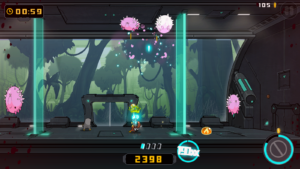
Harry, your protagonist, has quite the number of abilities at his disposal beyond the basic gun. Four other temporary guns spawn in via weapon crates and range from the strong laser beam, which excels at taking out strong enemies, to a lightning gun which spreads to hit a large area on contact, making it great for quickly taking out groups of weaker enemies or even for fighting stronger enemies which spawn other enemies. Sometimes you may get a more group-focused weapon when you really need a strong miniboss killer or vice versa, but these additional weapons are ultimately fun to use and still work at least as well as your default gun even when you’re not using them against the ideal opponents. In addition to the weapon crates, a meter fills up as you kill bugs and you can randomly use one of three special abilities (or four in Panic Mode) when it’s completely full. These special abilities can save both your life and your score when used well and include an ability which freezes every enemy for a few seconds, a dramatic boost to Harry’s movement and attack speed which also grants him invincibility, a barrage of missiles with some homing capabilities, and, in Panic Mode, a shield which covers a portion of the map for a few seconds to deflect both bugs and enemy bullets. Though these abilities are fun to use, the speed boost tends to be the best because of the combination of additional damage potential on top of full invincibility while the missile barrage doesn’t always hit its targets and often will crash into walls or platforms in later areas. Enemies will also drop various temporary buffs, such as double attack power and a movement speed boost, and combining these time-limited boosts with the ammo-limited weapons and the powerful special abilities can quickly turn the tide of an otherwise bleak-looking battle.
The final ability at your disposal, dashing, is the biggest game-changer of the lot. Harry is able to briefly perform short dashes, which gives him much more mobility than the Buster Brothers ever had and in turn allows for faster, more aggressive enemies and arenas which are slightly bigger than the single-screen arenas of Pang. The dash is also crucial for the scoring system in The Bug Butcher because your score is greatly affected by your combo meter, which increases by one each time you defeat any type of enemy and immediately disappears if you take a hit or fail to kill a bug within a few seconds. Dashing is a great addition which allows for interesting enemies in large quantities in big arenas with a strict combo system on top of being fun to use in its own right; it even can be used to shatter enemies near the ground after freezing them as an added bonus!
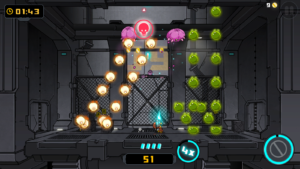
So Harry has quite a lot going for him both in terms of offense and defense, but the space bugs he must exterminate are often a far cry from the bouncing orbs and spinning shapes of Pang. Yes, there are giant blob-like insects which bounce around and split into smaller versions when defeated as well as strings of smaller insects which bounce in sharp diagonal angles, but there are many other types as well. For example, blue spider-like enemies will spawn on the ceiling and walk to above a scientist positioned near the center of the screen before sending down a tentacle to attempt to abduct him; you immediately lose if a spider manages to carry a scientist outside of the arena so these enemies periodically provide an entirely new type of threat to deal with on top of attacking and avoiding everything else. Harry can take multiple hits when you’re not playing on Hard Mode, but nearly all of the larger insects shoot out projectiles either at intervals or as a reaction to being attacked and with little in the way of invincibility frames your health can rapidly plummet between failed attempts at dodging both bullets and bouncing bugs. On top of nearly every larger enemy splitting into smaller version upon being eliminated, almost any of the ones which don’t shoot bullets make up for their lack of projectiles in spades by spawning even more small bugs either as a reaction to taking damage or simply over time, which can soon cause the arena to be flooded by a dangerously high number of enemies if they aren’t taken care of quickly. Not all of their movement patterns are as simple as bouncing either, such as in the case of large blue insects which will perform a few small hops upward, spawn two smaller bugs, and then immediately come crashing down to the ground. The enemy types work well together to prevent the combat from getting stale and some excellent animation work along with an ‘adorably disgusting’ art style allows each enemy type to possess a ton of personality on top of being immediately identifiable when things get hectic.

Arcade Mode is likely the first of the two modes most players will start with and it serves as a solid introduction to the game. In addition to a quick and well-made tutorial on the basic mechanics which results in the senseless destruction of coffee cups, Arcade Mode is split into five areas each containing six stages. Those looking for arena variety may be disappointed to know that there are only six arenas between these five areas; the first five stages in each area take place in a specific arena with the final stage taking place in a smaller elevator arena where weapon crates don’t spawn (the final area is an exception as the last stage of Arcade Mode takes place in the same arena as the five stages which came before it). With that said, the actual stages are quite involved as, rather than having every enemy in the stage present at the very start, enemies appear in multiple waves which in turn are divided into smaller sets. The distinction between waves and sets is actually very important as the next full wave won’t start until every enemy from the current wave has been eliminated, but sets of enemies begin to spawn in either when you’re down to a single non-splitting enemy from the current set or if you are simply taking too long. There’s also a strict time limit in which you must complete each stage on top of everything else; the time limit is very generous for early parts and I completely ignored it for much of the game, but I went over the limit several times and eventually won with a handful of seconds to spare in the last few stages.
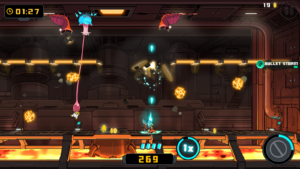
The small number of arenas is further made up for by how unique the arenas themselves are. Each arena has specific points from which enemies can spawn in and these spawn locations are on every surface, including the floor. Thankfully, symbols appear to give you ample warning when bugs are about to start crawling out of an opening and the strongest bugs are marked by special symbols so further let you know that you probably shouldn’t stand right next to where they’re about to appear. The first arena is ‘standard’ one as it is simply an empty, rectangular room, but unique obstacles are present in the others. The second and third arenas in particular allow for some interesting interactions on the player’s part. The third arena has two sets of three platforms which float in circular patterns and can give you some breathing room by blocking most types of attacks from any enemies which appear above them, but which also block your shots and make it very hard to deal with any enemies which are bouncing underneath them; you can destroy the platforms with a few shots and they’ll respawn after a few seconds so you need to decide when and where you want to shoot them while also being careful not to accidentally destroy them when there is something nasty on the other side. As to the second arena, there are two laser walls which periodically appear to split the arena into thirds before disappear after a few seconds and you can step on pads on either side of the walls to bring them down early, though there is a small delay between touching the pad and the wall disappearing, so these walls can prevent you from needing to face every single enemy in the room all at once, but enemies will rapidly build up in these confined areas if you aren’t also actively moving from one segment to another, especially if a spawner enemy is present. The elevator provides its own unique challenge with its small size and its lack of weapon boxes and the remaining arenas likewise have defining gimmicks, though ones which are almost entirely hazardous and which you aren’t able to interact with as directly as in the second and third arenas.
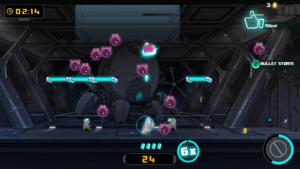
There are a few remaining unique traits to mention about Arcade Mode before moving on. Each of the special abilities and weapons unlocks after reaching a certain stage, though you’ll have access to the last of the lot by the end of the second area. Enemies also drop coins which can in turn be used to upgrade the stats on every weapon, including your base gun, or to make the special abilities stronger, usually simply by making them last longer. There are also three fairly expensive ‘perks’ which you can buy; you can’t level up perks and you can only have one of them equipped at a time, but they include a significant movement speed boost, a damage shield which absorbs a hit without breaking your combo counter, and an extension for the amount of time you have before the combo counter resets. Each stage also has a minimum combo count to aim for as well as three score-based stars to obtain (and you’re probably not getting that third star without getting the combo count). These extra goals don’t serve much purpose beyond providing achievements, though stars do give you a fairly substantial amount of bonus money. The inclusion of an upgrade system is a nice one, but it is a simplistic one which seems to serve more as a way of familiarizing you with the game as each weapon and ability maxes out within three upgrades since you increase every attribute of a weapon with a single boost rather than picking and choosing individual stats to increase. As long as you’ve earned at least a few stars along the way you’ll almost certainly have everything unlocked and maxed out by the end, or close to it. Three different difficulties exist, but the only difference I noticed between them was the amount of health you have and your character’s appearance and you can go back to any stage you’ve accessed at any time regardless of the difficulty you were playing on when you unlocked it. Overall, this is a solid mode which you can either blaze through in a handful of hours or spend significantly more time on if you want to get every star and/or earn a high position in the online leaderboards, but it’s also an all-around barebones experience with no real twists or surprises beyond the elevator stages and a few lines of dialogue here and there.
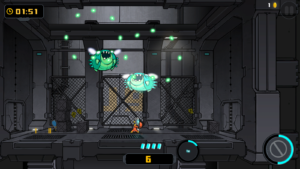
Panic Mode is what the campaign ultimately feels like it’s designed to prepare you for and this is certainly where you’ll find the most brutal challenges and the most competitive online rankings. You can choose from five different arenas in this mode, which are identical to those in the Arcade Mode with the exception of the elevator, which isn’t available. The ‘Easy’ difficulty setting from Arcade Mode is also not present here, but there are separate leaderboards for Normal and Hard. Also unlike Arcade Mode, the goal here is simply to get as high of a score as possible before inevitably succumbing to the increasingly-difficult waves of bugs. There is still a timer here, but since the game only ends once you die or run out of time it works a bit differently as enemies will now drop time-increasing clocks alongside coins and clearing a wave will grant you a ‘time bonus’. You have access to all of the guns and abilities from Arcade Mode, in addition to the shield ability I mentioned previously, but now you can buy them from the pause menu while in a stage and they no longer need to be upgraded. You also get a boost to the rate at which weapon crates appear for buying every weapon and a boost to the rate at which the special meter charges for buying every ability, which incentivizes you to buy everything rather than just your favorite gun and ability. More weapon crates and a faster charge rate are a good way to balance out the increased randomness factor, but I think it would have been better if this rate increased with each purchase instead of an all-or-nothing approach, especially since weapons are in mystery crates in Panic Mode rather than the clearly-marked crates of Arcade Mode. One particularly major change comes with the perk system as you can now have every perk simultaneously, and for a much cheaper price, though the shield can only be purchased a single time per run and there’s a new perk in the form of a one-time maximum health increase which also serves as a full heal upon purchase. Enemy waves are randomized, but Panic Mode throws a much higher number of enemies at you simultaneously compared to Arcade Mode and, while you won’t see the strongest enemies in the game on the very first wave, any enemy or combination of enemies can appear in any arena and the difficulty ramps up so quickly that the farthest I’ve managed to make it is to near the start of Wave 6. This is a fast, brutal, and highly competitive mode and, in other words, it’s exactly the type of thing any good arcade game should have.
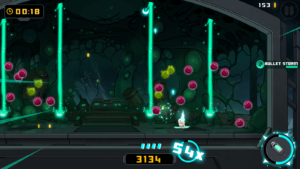
As solid as the main gameplay of The Bug Butcher is, there are several issues which crop up along the way. Most of these are related to the menu and usually don’t affect gameplay, but they can be annoying. One thing you’ll almost certainly notice right away is the fact that the game launches in fullscreen mode, which isn’t an issue in and of itself, but there does not seem to be any option for resizing the window. The menus can also be a bit tricky to navigate and at times it can be difficult to tell what is even currently selected because so many different parts have a faint glowing effect on them; you can navigate through the menus with the mouse, which does make things significantly easier, but players shouldn’t feel compelled to do so in the first place for a game where the ideal way to play is with a controller. There were also three minor menu oddities, the first of which is the fact that just which button is used to replay a stage changes depending on if you are already in the stage or if you are on the completion screen, the second of these oddities seems to be a bug in Arcade Mode where sometimes it would tell me that I obtained a new high score even while clearly displaying a higher previous score on the side, and the third strange menu issue is the start of Panic Mode would consistently state that I was playing on ‘Hard’ even after selecting Normal from the menu (this is purely an aesthetic bug as my health and leaderboard standing were both still tied to Normal). As for issues which affect the gameplay itself, coins disappear if you don’t pick them up after a few seconds, but there is no animation or other effect to warn you that a coin is about to disappear and it is virtually impossible to differentiate ‘old coins’ from ‘new coins’ with enemies bouncing around and spraying money everywhere. Lastly, I found it odd that there each stage in Arcade Mode has a single leaderboard shared between the difficulties even though Panic Mode has separate leaderboards between Normal and Hard for each arena.
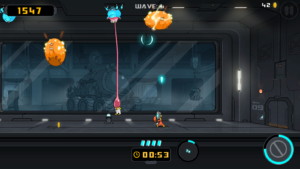
Despite being afflicted with a few bugs and other minor issues of its own, The Bug Butcher should be considered a must-buy game for most fans of the genre, especially considering how unfortunately uncommon these types of games are, as it keeps all of the essential elements in place while bravely and successfully expanding upon them and implementing many new ideas along the way.